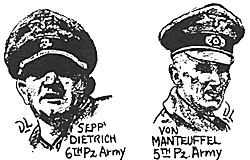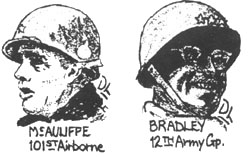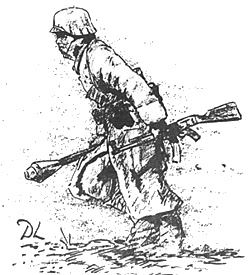A review of Battles for the Ardennes, Part 1

EVALUATION: Let me list BA's weaknesses and flaws first:
1. On the turn record track for the 1944 campaign game there is a printing error. What should be listed as "2 Jan PM," shows up as "2 Dec PM."
2. All of BA's graphics are excellent except for the color used for showing the roads and towns. This medium gray tends to get lost in the green of the light-woods, and towns in that type of terrain really can go totally unseen. (To the great shock and consternation of many an attacker, who, thinking he had some key crossroads attack all set-up, moved on to other matters, called an end to his movement phase and then could only gasp, rend clothes and gnash teeth when his smiling opponent lifted the units to reveal the heretofore cleverly camouflaged village homes!) A bright red or orange, though perhaps artistically bordering on the garish, would have been much more utilitarian here in making these two crucial terrain features prominent.

3. When using forced-march procedures units become "fatigued" and suffer a state equal to being out-of supply, except that the onset and end of the fatigued state occur at different turn-phases than the supply determination phase. Thus there is a need to distinguish between units normally out of supply and units suffering those same effects due to force-marching. That Mr. Parker was cognizant of this is shown when he writes, "If players wish, they may use some other type of markers to differentiate between units out of supply as a result of forced march and units out of supply normally." Now, in all other respects the player-aid informational counters included in BA are not only adequate, they are superb, and as I look through my storage tray I count over fifty blank counters that go unused throughout play of the game. Why, then, I must ask, especially since Parker makes it clear he's aware of the need for them, couldn't we have had some of those blanks printed into fatigue counters? This is admittedly a very small point, the need for fatigue markers is minimal in play, but it does point out that even the best efforts at design in our hobby can still be marred by incomplete development.
4. In the 1940 campaign game, several German infantry divisions are given start hexes which place them well into enemy territory prior to the start of the invasion.
5. The printing on some of the combat engineer units is spotty, which, again, is a very minor point, but is nevertheless a sad one given the attractiveness of all the rest of the game's units.
6. All the artillery units in all of the games share a common range of three hexes. Given the wealth of data now available on this battle, this is a needless abstraction. Surely the artillery counters could display one more factor, and having to check your ranges before going into battery position would have in no significant way added to the game's complexity.
7. The same charge of needless oversimplification can also be leveled at the stacking rules. At two miles per hex, history would not have been distorted if the four unit divisions in the games were allowed to concentrate on one hex. Indeed, the critical notion of Schwerpunkt would have been much enhanced.
8. The rules contain an extensive historical article on the battles covered in BA, but we get less than a page of "Designer's Notes" from Mr. Parker. As soon as you begin playing BA it becomes obvious that a great lot of thinking and imagination went into perfecting its smooth system and elegant mechanics, and I think I speak for a broad segment of the hobby when I say players are very much interested in coming to understand those creative processes which go into the games they play. At the same time, even the smallest history section of the smallest public library is bound to contain .some work on these monumental battles, so that I believe BA's overall presentation would have been enhanced by a trade off of space between these two features to the advantage of the Designer's Notes. Histories of the battles simulated here are available more or less easily to all of us, but deep insight into the workings of this game are open only to those with ready access to Mr. Parker.
Praise
But enough on the negative side; today I am here to praise a game, not bury one!
When I first saw this game "feedbacked" many issues ago in S&T, I was afraid what we were going to end up with would be four separate mini-games which would then be squashed together in any way necessary to produce the campaign versions. Happily, this is not the way things worked out. Though he doesn't mention it in those too short designer's notes, it seems obvious from play that Parker first designed his campaign games, tuned them to his and history's liking, and then divided into quarters to produce the mini-games. The results are more than satisfying. Before this title came out I'd have laughed at anyone who suggested I'd get excited over yet another "Bulge" game. And, again happily, I was wrong.
The '44 campaign game is so well designed and developed it's simply a pleasure to play. Its excitement level is high throughout, despite its size (though I realize that by today's standards it's not a really big game) it's perfectly manageable, and its victory conditions allow the German player the maximum flexibility reasonable to the historic situation. At the same time, the three 1944 mini-games are also winners. Though most of the attention seems so far focused on "Celles," I urge players not to overlook "St. Vith" and Clervaux."
Another thing that surprised me about BA is the 1940 game. Now, I still don't like the damned thing, it reminds me of a Cobra game in reverse, but at the same time I must admit that that is a purely subjective opinion, which I'm finding is held by few besides myself. (I was stunned when issue #62 of Swabbers magazine reached me as I was writing this article, and upon reading Mr. Colleran's review of BA, found he recommended the game apparently without even having looked at the 1944 games!)
Let me try and explain my perspective on the 1940 games. To begin with, to say the Franco-Belgians get overrun is putting things more than mildly, they get decimated. The German units smashing down those roads of the 1940 Ardennes, both the mechanized and the non-mechanized, are the best of the best in terms of both speed and strength, benefit from a wealth of tactical air support so ubiquitous as to be embarrassing, don't get tired when they force march, and have artillery whose effects can only be compared to thunderbolts. This is Blitzkrieg at its best, and almost paradoxically, its most boring. This is not a contest between two players so much as it is a map exercise for the German. The many I find around me who oppose me on this do so by pointing out that in order to be true to history Mr. Parker had to lay things out that way, and then they go on to argue that he still served good gaming by giving the Germans a severe set of victory conditions to fulfill. And when I shake my head and begin to reply, they hold me off further by saying that in some of my earlier writings I've praised designers for pulling off this same feat of turning history's imbalances into game design triumphs through the same use of severe victory conditions.
All of which is true as far as it goes. That is, yes, the game is balanced (i.e., the French/Belgian player "wins" about as often as does the German player), because the victory conditions require, in general practice, that the Nazis kill everyone, capture everything and exit almost everything while losing almost nothing in order to win. And yes, I have lauded this sort of thing before. Rut it just doesn't wash for me here.
If you were to enter a room in which the 1944 BA campaign game had just been played out and were to look at the board, you'd be able to tell immediately which side won. In a German victory situation you'd see a cordon of Wehrmacht and SS units stretched from the east board edge to one of the other sides. At the place where this "bulge" contacted the other board edge there'd be neatly stacked piles of exited mechanized units', kept there to make for an easier tallying of victory points (and to psyche-out the American player). At the same time, scattered along the edges of the German advance, and perhaps surrounded within it at a few places, you'd see the burned out remnants of once powerful American divisions. The German player will be perspired, smiling broadly, and if he's a tobacco user, literally be sucking up a cigarette, trying to get his nicotine level up to where his hands will stop shaking. The American player will not be looking anyone in the eye, will hurriedly commence to put the units away, and all the while be mumbling something about if only such and such a division had held at that crossroads one more turn. American victories present much the same picture, with player roles reversed of course, a larger German dead pile, and a bulge that just doesn't quite make it to a board edge.
If you were to enter that room at the end of a 1940 game, however, you'd encounter an entirely different scene. The vast majority of units of both sides are located off the board's western edges. The Germans haven't so much created a bulge here as the Allies have held on to toe holds on the western board comers. The Belgian Army is neatly bottled north of the Meuse, or else it's simply gone. The French (remnants is the word) are penned in the southeast, and huge quantities of mechanized National Socialists are off the west board edge on their way to the Channel Coast.
German or Allied victory, it doesn't matter, things look pretty much the same. In the latter case, there's one or two more German mechanized units flipped over to their weaker side, and a couple fewer off the board, but the general impression of pitiless carnage and bloody massacre is just the same. If he won, the German is saying, "Wow, I really thought I wasn't gonna get those last guys off in time! That counter attack you pulled at X was really amazing! 'Course, yuh can't beat Stukas and Panzers, man! " The Allied player is looking off into space. If the German lost, he's really embarrassed and silent and his opponent (if a good friend) is saying, "Yeah, well, of course this still wouldn't change the campaign's outcome, really. You really screwed yourself when you moved that infantry outfit first and blocked that road all up ..."
Perhaps I'm being unfair here. That the state of the art of our hobby has advanced to the point where we can even talk of getting a balanced, historic presentation of so many different battles in one package is cause for great joy. (Remember those articles that told you how to get across the Nieman River in Stalingrad by October, 1941!? We have come far!) My dislike for the 1940 games is no doubt simply due to my dislike for the history of that part of the war in general. Never before were the "good guys" so easily beaten and humbled, never before was it so completely demonstrated that once fine military machines could, within the space of a generation, deteriorate into something less than mobs. But before I start on cyclic theories of history, or begin making comparisons between the 1940 Wehrmacht and a well known mechanized force of today, and all the lessons to be learned therein, I'll drop this dangerous and disturbing line of thought.

For my money, I'd rather have seen the capital and effort that was put into the 1940 games used instead to provide us with maps and units of the 1944 front up in the Aachen area. Then we could have fought out the much talked about, but never yet gamed out, "small solution," the proposed substitute to Hitler's "grand slam" attempt in the Ardennes, the encirclement and recapture of Aachen and the Westwall fortifications in that area. Perhaps in the future.
I'll close by saying do get this game, all of you. It's a true state of the art masterpiece, which at one swoop has moved Danny Parker to the front ranks of designerdom. Further, for $14.00 it's one of the best dollar buys presently on the wargame market. If you like Cobra, you'll love the 1940 games. But (I can't resist a parting shot) if you thrill to the imagined sound of huge diesel engines reving on a foggy, cold morning, the scrape of hob nailed boots dashing across winding, frosty roads, the krumph! krumph! krumph! of massed 88s, or the banshee scream of Nebelwerfers pulling unsuspecting men from their dreams, or if your heart beats faster at the thought of P-47s turning Panzer regiments to flaming, roiling scrap metal, or if the hair on the back of your neck stands up when you see ' paratroopers fix bayonets and, smirking, turn to repel yet another onrush of grayclad berserkers, in short, if you like a good fight, then play the '44 versions. You'll flip.
Back to Campaign #92 Table of Contents
Back to Campaign List of Issues
Back to MagWeb Master Magazine List
© Copyright 1979 by Donald S. Lowry
This article appears in MagWeb (Magazine Web) on the Internet World Wide Web. Other military history articles and gaming articles are available at http://www.magweb.com